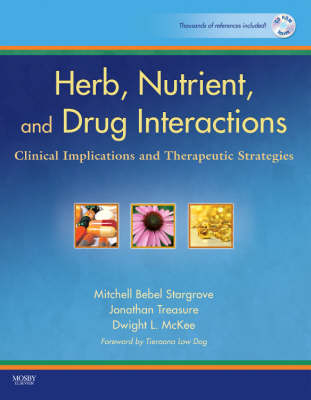
Herb, Nutrient, and Drug Interactions
Mosby (Verlag)
978-0-323-02964-3 (ISBN)
Presenting detailed, evidence-based coverage of the most commonly encountered therapeutic agents in modern clinical practice, this resource is designed to help you safely and effectively integrate herbal, nutrient, and drug therapy for your patients or clients. Combining pharmaceuticals with herbs or supplements may complement or interfere with a drug's therapeutic action or may increase adverse effects. Additionally, drug-induced depletion of nutrients can occur. Comprehensive clinical data, quick-reference features, and the insight and expertise of trusted authorities help you gain a confident understanding of how herbal remedies and nutritional supplements interact with pharmaceuticals and develop safe, individualized treatment strategies for your patients.
More than 60 comprehensive monographs of herb-drug and nutrient-drug interactions cover the most commonly used herbs and nutrients in health-related practice and help you coordinate safe, reliable therapy.
Each herb and nutrient monograph features summary tables and concise, practical suggestions that provide quick and easy reference and complement the systematic review and in-depth analysis.
References included on the bound-in CD provide high-quality, evidence-based support.
Unique icons throughout the text differentiate interactions, evidence, and clinical significance.
Up-to-date information keeps you current with the latest developments in pharmacology, nutrition, phytotherapy, biochemistry, genomics, oncology, hematology, naturopathic medicine, Chinese medicine, and other fields.
A diverse team of authoritative experts lends valuable, trans-disciplinary insight.
Interactions Probability, Significance and Source Strength Guides
Section I: Herbs Interacting with Drugs
Aloe (Aloe vera)
Astragalus (Astragalus membranaceus)
Bilberry (Vaccinium myrtillus)
Black Cohosh (Cimicifuga racemosa)
Cascara
Cayenne (Capsicum)
Dang Gui (Angelica sinensis)
Devil's Claw (Harpagophytum procumbens)
Echinacea (Echinacea spp.)
Eleuthero (Eleutherococcus senticosus)
Ephedra (Ephedra sinica)
Feverfew (Tanacetum parth.)
Garlic (Allium sativum)
Ginger (Zingiber off.)
Ginkgo (Ginkgo biloba)
Ginseng, Chinese/Korean (Panax ginseng)
Gotu Kola (Centella asiatica)
Green Tea (Camellia sinensis)
Hawthorn (Crataegus)
Horse Chestnut (Aesculus hippocastanum)
Kava Kava (Piper methysticum)
Licorice Root (Glycyrrhiza glabra)
Milk Thistle Seed (Silybum marianum)
Red Clover (Trifolium pratense)
Reishi Mushroom (Ganoderma lucidum)
Saw Palmetto (Serenoa repens)
St. John's Wort (Hypericum perforatum)
Turmeric/Curcumin (Curcuma longa)
Valerian (Valeriana off.)
Vitex/Chaste (Vitex agnus-castus)
Section II: Nutrients Interacting with Drugs and Drug-Induced Nutrient Depletions
A. Vitamins
Beta-Carotene
Folic Acid
Vitamin A / Retinol
Vitamin B1 / Thiamine
Vitamin B2 / Riboflavin
Vitamin B3 / Niacin/Niacinamide
Vitamin B6
Vitamin B12
Vitamin C / Ascorbic Acid
Vitamin D / Calciferol
Vitamin E
Vitamin K
B. Minerals
Boron
Calcium
Chromium
Copper
Iron
Magnesium
Potassium
Selenium
Zinc
C. Amino Acids
Arginine
Carnitine
Methionine
Phenylalanine
Tryptophan
Tyrosine
D. Nutriceuticals and Physiologics
5-HTP (5-Hydroxytryptophan)
Alpha Lipoic Acid
Chondroitin Sulfate
Coenzyme Q10
DHEA (Dehydroepiandrosterone)
Glucosamine sulfate
Inositol
Melatonin
Omega 3 Fatty Acids (including Fish Oils: DHA and EPA)
PABA (Para-aminobenzoic Acid)
Policosanol
Probiotic Intestinal Flora and Prebiotics
S-adenosyl Methionine (SAMe)
Section III: Cross Indexes
A. Drugs by Trade Names
B. Drugs by Generic Names
C. Drugs by Drug Classes
Index
| Erscheint lt. Verlag | 22.1.2008 |
|---|---|
| Verlagsort | St Louis |
| Sprache | englisch |
| Maße | 216 x 276 mm |
| Gewicht | 1950 g |
| Themenwelt | Medizin / Pharmazie ► Medizinische Fachgebiete ► Pharmakologie / Pharmakotherapie |
| ISBN-10 | 0-323-02964-7 / 0323029647 |
| ISBN-13 | 978-0-323-02964-3 / 9780323029643 |
| Zustand | Neuware |
| Haben Sie eine Frage zum Produkt? |
aus dem Bereich


